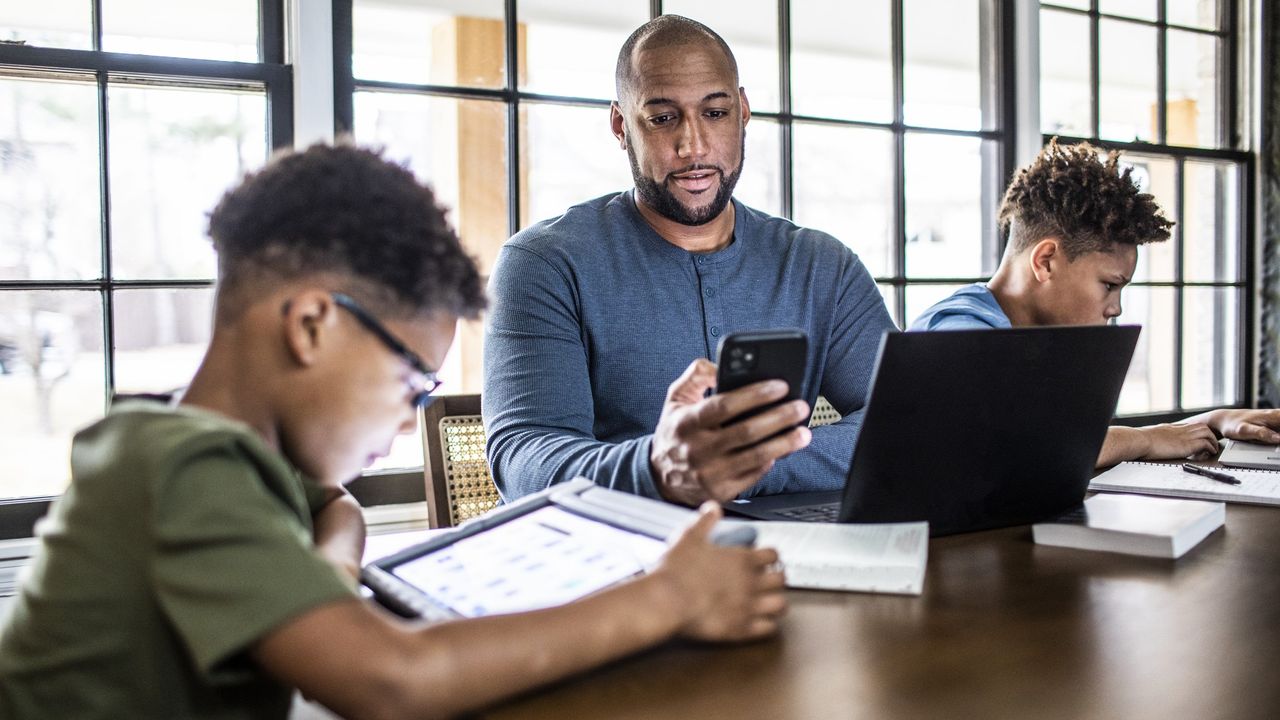10 ways to protect your child's privacy and identity online (#3 is good advice for all of us)
From protecting passwords to not oversharing - here's how you can make sure your child's privacy and identity isn't under threat

If you're worried about how safe your kid is when they're on social media, playing games online or shopping via their favourite websites, you're not alone. The dangers to their online privacy and identity are real, but we have expert tips to help you protect them.
When it comes to our kids being online, most parents are worrying about how bad social media is for kids and whether it exposes them to grooming, cyberbullying and poor mental health. However, invasion of privacy and identity theft aren't far behind, especially as kids get more sophisticated at using apps, games, sites and social media. So, is it ever ok to check your child's phone? And where do you find expert-led tips for internet safety?
We've talked to cybersecurity and privacy experts to discover clever ways to ensure your child's identity and privacy are secure, from password protection to knowing what personal information isn't ever ok to share.
10 tips to protect your child's privacy and identity online
- Check social media privacy settings
- Understand the risks of Smart home devices
- Create strong passwords with a password manager
- Educate your kids about data privacy and personal information
- Warn them about public Wi-Fi risks
- Monitor online activities where you can
- Let them know the dangers of oversharing
- Discuss the risk of online-only friends
- Review security on all their devices
- Check what's public already
1. Check social media privacy settings
Sit down with your child and review the privacy settings on all the social media apps and sites they use, including Facebook and Instagram. Make sure their accounts are set to private, limiting what people can see. Remember that not all social media sites have privacy settings enabled as standard, and some even feature location trackers, so it's worth going through everything with a fine tooth comb.
Cybersecurity expert and dad Michael Hasse has more. "Fortunately nowadays, most social media platforms strip that data by default - but do confirm that because new services come along all the time. Always be aware of what your child is using."
Michael also recommends checking privacy settings periodically. "Always recheck settings. Many services are notorious for 'accidentally' resetting everything to default settings when updates are deployed."
2. Understand the risks from Smart home devices
It's easy to focus on your child's laptop and phone, but be aware of the other Smart devices in your home, such as Amazon Alexa, the Smart TV, and other internet-connected toys such as game consoles or Smartwatches. You can usually set parental controls or privacy settings on all of the above and help your child avoid broadcasting their location or other personal data.
GoodtoKnow Newsletter
Parenting advice, hot topics, best buys and family finance tips delivered straight to your inbox.

You can also download additional apps and software to add further layers of protection. Internet Matters has a great guide to doing this for lots of popular Smart devices, from Amazon Echo to Sonos. A note on streaming content, however: device controls aren't able to filter out specific types of content on platforms such as YouTube, Netflix or Chrome. You’ll also need to set these controls separately.
3. Create strong passwords with a password manager
All the online security experts we spoke to agreed setting strong passwords using a password manager is crucial.
"Humans, in general, are bad at choosing strong passwords," says Josh Amishav, Founder and CEO of Breachsense. "They also tend to reuse passwords in multiple locations. By having a password manager generate a password for you, you can have a complex password for each app without having to remember it.
"Password managers can automatically fill in your credentials when logging into apps and websites. However, they won’t autofill on phishing or lookalike sites. By relying on the password manager for authentication, you can reduce the risk of disclosing your information in a phishing attack."
Christophe Van de Weyer, CEO of Identity Solutions Provider Telesign, advises taking it even further. "A password - even a strong one - just isn’t enough to keep accounts safe from hackers," says Christophe. "You need to use multi-factor authentication (MFA) to add an extra layer of security with one-time passcodes through text, email, or an authenticator app. This only adds a few extra seconds when you log in, but it can give you peace of mind that your kid's account is secure."
4. Educate your kids about personal information and data privacy
First up, let your kids know that it's not ok to share the following personal information online, especially in conversations with strangers on gaming sites or social media. Personal information includes, but isn't limited to:
- their full name
- their address
- contact info such as email addresses and phone numbers
- where they go to school
- photos of themselves
- passwords or information about themselves that could be in their password (e.g. a pet's name)
Have an open and honest conversation with your child about data privacy. Show them examples of where someone's data privacy was breached and what happened as a result. You can find plenty of alarming examples of this on the internet. Let them know how difficult it is to remove information and images from the internet, even if it's shared of a platform that promises disappearing messages, like Snapchat.
Yaron Litwin, CEO of Canopy Parental Control App, says we need to teach our kids how to minimise their digital footprint. "Teach them that the internet is forever! The less they post now, the greater their chances of a relationship or career in the future."
Michael Hasse agrees. "Treat a stranger online just as you would a stranger in real life. In other words, don't share information and be wary."
5. Warn them about public Wi-Fi risks
Public Wi-Fi networks are less secure than private ones. When your child connects to a public Wi-Fi network, the data they send and receive can be intercepted by hackers if the connection isn't encrypted. That means personal information, such as login details, could be stolen. There's also a risk of a malware attack on the device if hackers have set up a fake Wi-Fi hotspot.

Sounds scary, so what can you do? Setting up a virtual private network (VPN) is the safest option as it encrypts data as it goes to and from your child's device. However, it won't protect it from malware or viruses. So, if you're still unsure, ask your child not to connect to public Wi-Fi services when they're out and about, even when they're out of data.
6. Monitor online activities where you can
As kids get older, they will likely bypass the parental settings you set up, sometimes in just seconds. Device and software updates can also disrupt these settings. That's why it's crucial to review privacy settings with your child regularly.
Many parents prefer to use parental control and monitoring tools. These tools let you see your child's sites, searches, and messages, allowing you to step in if necessary.
However, Michael warns this approach tends to bypass trust, which is essential to having open and honest conversations with your child about internet safety. "This is a tough one, depending on the age and personality of the kid," says Michael. "My wife and I opted to trust our kids, making it clear we felt they were mature enough. Part of the challenge is that most parental control systems are easily bypassed, teaching kids to hide things from you."
Michael suggests waiting until your child is a teenager before giving them a smartphone and keeping a computer in a shared family room for schoolwork. "This approach let us casually monitor their online activity and helped avoid internet use interfering with sleep," he says.
7. Let them know the dangers of oversharing (and geo-tagging photos)
Teach your kids to be cautious about sharing on social media, especially with geo-tagged photos. Sharing too much personal information or location can expose them to dangers like identity theft and predators. Even sharing holiday photos with geo-tags can alert burglars that your home is empty.
Agya Gard, mum of three and Head of Product at online safety firm Aura, has more on the dangers of oversharing. "Scammers and predators can easily pose as one of your children's friends in an effort to obtain private information. Have your children discuss with their peers if they have social media accounts, and share their usernames to ensure they are actually speaking with who they claim to be."
Agya tells GoodtoKnow some alarming statistics about identity theft and kids. "An underage child has no idea that scammers can steal their identity. Yet, more than 1.5 million children in the United States had their identities stolen in 2022. Children can accidentally reveal sensitive information online that scammers can use to take out fraudulent loans and credit cards or run other scams."
8. Discuss the risk of online-only friends
If your child enjoys Instagram and Facebook, messaging apps and online games, they could have hundreds or even thousands of contacts. So it's vital to talk to them about what constitutes a 'friend' online. Remind them only to share information about themselves with people they know in real life and let them know that not everyone they meet online has good intentions.
It's likely that they've already talked about this in school (stranger danger), so it's fine to continue the conversation at home. It's a good idea to teach your kid how to recognise 'red flags' when it comes to chatting with people online, such as:
- asking lots of personal questions
- asking to meet in real life
- asking for images or videos of your child
- inconsistencies in personal information
- sharing inappropriate content
- asking to move to more private conversations from a public network
- asking your child to share location details
9. Review security on all their devices
Go through each of your child's devices and make sure location services are turned off for social media, games and messaging platforms. Also, check that they have the latest version of their device’s operating system installed to keep their security up-to-date and enable automatic updates.
Check their contacts list regularly to make sure there are no unfamiliar names or numbers. If your child is older, you may wish to ask permission or do it together.
10. Check what's public already
Search your child's full name in several search engines to see what information and photographs are public. Search in incognito browsers too, so you can be sure search results are not influenced by your own, or your child's, search history.
The search results will help you identify any photos or information about your child that might be accessible to others, so you can contact the websites or service providers to have it removed. If your child has any old, unused accounts, help them delete those accounts to declutter their digital footprint and ensure nothing is left to chance.
Featured experts

Michael Hasse has several decades of experience with cybersecurity operations for hundreds of companies, including utilities, healthcare, insurance, manufacturing and datacentres. He's also a dad.

Josh Amishav is the founder and CEO of Breachsense, a cybersecurity firm.

Yaron Litwin is an online safety expert and CMO of Canopy Parental Control App, an AI-powered solution that filters and monitors harmful and explicit content in real-time.

Christophe Van de Weyer is the CEO of Telesign, a company based in the US that provides digital identity and programmable communications APIs to prevent fraud.

Agya Garg is a mother of three kids ages 10, 8 and 1, and Head of Product at Aura, the all-in-one online safety solution that helps protect individuals and their families against online crime.
Discover more advice and information on keeping your kids safe online, from How bad is social media for kids in general to the eight things experts want parents to know about Instagram. Plus, what you need to know about cyberbullying, including the sites and apps all parents need to be aware of.
Joanne Lewsley is mum to a tween, and freelance copywriter and editor who creates parenting, health and lifestyle content for evidence-based websites, including BabyCentre, Live Science, Medical News Today and more.
-
 Why do I crave sugar? Causes of sugar cravings and how to stop them
Why do I crave sugar? Causes of sugar cravings and how to stop themIf you're someone who suffers from sugar cravings you'll know how hard it is to give up the sweet stuff. But you're not alone.
By Debra Waters Published
-
 Low sodium diet: the benefits of reducing salt and what foods to eat
Low sodium diet: the benefits of reducing salt and what foods to eatBy Emily-Ann Elliott Published
